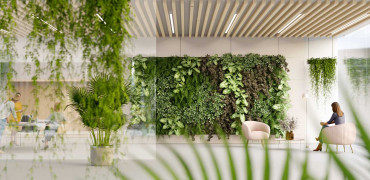Over recent decades we have experienced several heat waves, however climate change is making these moments more frequent, hotter and longer.
In many countries, extreme and intense heat waves kill more people than any other natural disaster.
55% of the world's population live in cities, a number that is set to increase continually until 2050.
Urban temperature rises present us seriously with a life-or-death challenge. When temperature soars above 25 Centigrade there is an increase in strokes and mortality.
UK heat-related deaths are set to increase by 275% by 2050 with a warmer climate and rapid population growth as standard.
In order to mitigate not only the increase in temperatures but also the urban heat island in our cities, we will need to address the way in which we live, work and socialise.
Seeing as we are unable to re-plan and build our urban systems from scratch, we need to consider how we can not only decarbonise, but how our urban spaces are designed and how they function.
With more places beginning to see higher temperatures, these design concepts may soon become mainstream
The things we can do
Climate change will continue to present a design problem to architects and urban planners across the globe. However, there are a few key things that can be done in new and existing urban sites.
All transport should be electric, neighbourhoods and amenities should be walkable, and greenery needs to become abundant throughout our cities to help trap and store the carbon and heat we so readily produce.
Green roofs, living walls and urban forests will benefit us all with impressive impact. As well as the obvious carbon capture, planting immediately reduces the temperature of our buildings and also offers shade.
We will also need to learn important lessons from other hotter cultures, look back at our ancient buildings and combine this knowledge with technology and our imagination of the future.
Coping with heat
People in desert areas have long been able to find ways of living with the heat, in the Far East homes are built on cooling stilts and in Europe courtyards and parks are commonplace.
In Phoenix Arizona, the firm Studio Ma is designing elements into their buildings to future proof against the increasing heat. Elements such as shading, prominent overhangs, and cantilevers, all have a passive cooling effect.
By using lighter building materials to insulate such as wood and avoiding heavy stone and masonry buildings can have a more manageable temperature.
If done correctly, homes that are built now will be resilient in the future.
Architects around the world are designing homes and buildings with passive solutions to mitigate increasing temperatures and more frequent heat waves.
New materials, advanced heat modelling techniques, and historically proven principles are showing that even when temperatures hit unexpected highs, our homes and buildings will be able to stay cool with natural flows whilst remaining sustainable.
Learning from our neighbours
Since 2002 the UK has experienced the top ten hottest years since records began, it is imperative that homes are now designed with simple, effective cooling technologies and architecture.
Instead of simply importing a reliance on air-conditioning from our southern European neighbours, each UK home should also utilise passive cooling techniques such as external shading over each window and cross flow ventilation.
Internal shading of a home allows roughly 90% of heat into your home whereas external blinds keep out around 90%. External shading can be as simple as parasols, awnings, trellis, trees, shutters, or external blinds.
Simple design techniques such as setting windows deeper into the reveals or having larger overhangs on the roof can be a straightforward and relatively cheap tweak that architects can employ.
White external walls will also reflect the sun’s heat and green living walls will provide shade. High ceilings, concrete floors and stone walls all help mitigate unwanted temperature rise.
A passive approach
The world will feel different, it does feel different.
With more places beginning to see higher temperatures, these design concepts may soon become a mainstream part of architecture and transferable throughout the world from country to country.
Every part of the earth that humans inhabit will be affected, if we don’t wish to contribute to global warming then more passive methods will be employed and building services will work seamlessly with each other.
It’s time to adapt.
Kirsty Hammond, Editor of Specifier Review




